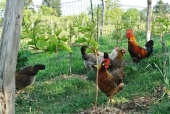








How permies.com works
What is a Mother Tree ?








Buy Our Book! Food Web: Concept - Raising Food the Right Way. Learn make more food with less inputs
Off Grid Homesteading - latest updates and projects from our off grid homestead












Today I will do what others won't, so tomorrow I can do what others can't.




'What we do now echoes in eternity.' Marcus Aurelius
How Permies Works Dr. Redhawk's Epic Soil Series
















'What we do now echoes in eternity.' Marcus Aurelius
How Permies Works Dr. Redhawk's Epic Soil Series
















Todd Nease wrote: My farming of them has gone wild, yet it only takes up a 4x4x3 foot area. The cost of inputs is minimal, and can possibly be reduced to nothing.




“Enough is as good as a feast"
-Mary Poppins




 1
1














Keira Oakley wrote:@ Matu: chestnut weevil larvae? how big are they? I think they must taste real nice because grubs take on the flavour of their food... although, yes you might need to fry them, raw might not be a good option, as raw chestnuts aren't really edible.
I have one question. Does anyone know how to farm waxworms? They live on honey in beehives, but on the internet they only show an artificial way how to breed them: giving them a mixture of honey and cereals, in glass jars, but normally they don't live on cereals. Would be nice to more learn about those "waxies", they taste real nice.
“Enough is as good as a feast"
-Mary Poppins








"Stranger, you's a tresspassin' on my dirt farm."
-Cletis the slack jawed yokel




















Paul in Warrensburg

|
CLUCK LIKE A CHICKEN! Now look at this tiny ad:
Learn Permaculture through a little hard work
https://wheaton-labs.com/bootcamp
|



